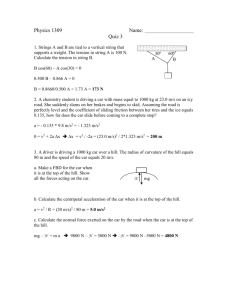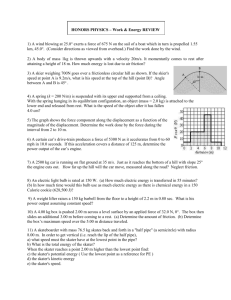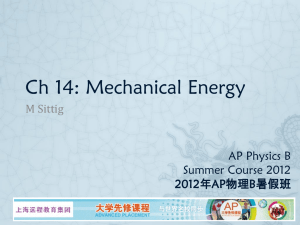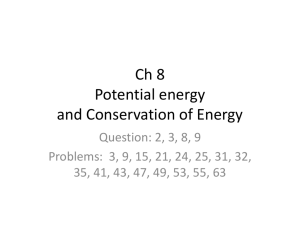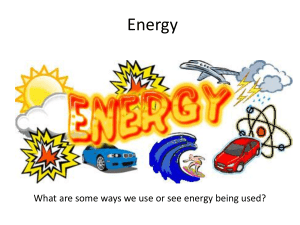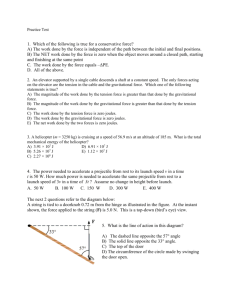ppt
advertisement
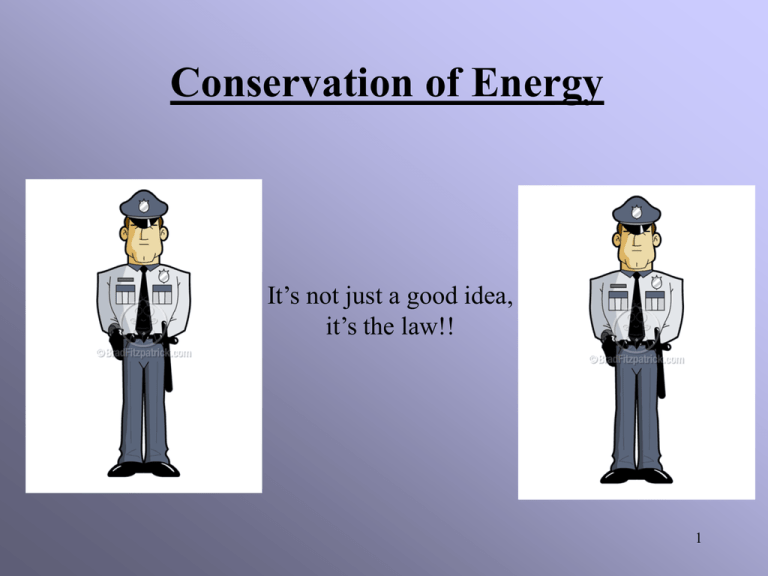
Conservation of Energy It’s not just a good idea, it’s the law!! 1 The Law of conservation of energy states that; “Energy cannot be created or destroyed simply transformed.” 2 Example: A ball sitting on top of a table has gravitational potential energy. The ball then falls off the table and hits the ground. Was all the gravitational potential energy lost? Was all of the energy lost? Explanation: As the ball falls from its initial position it started to gain velocity. This gain in velocity then results in a gain in kinetic energy. So as the ball falls further, it goes faster, thus the gravitational potential energy decreases and the kinetic energy increases. There has been a transfer of energy from gravitational potential energy to kinetic energy. With no net energy loss. 4 Example: A square pig of mass 50 kg is released from rest at a height of 10.5 m above the ground. With what velocity would pig hit the ground? E g m gh E g 50 9.8 10.5 E g 5145 J Ek 1 mv 2 v 2 2Ek Eg Ek v 2Eg m m v 2 5145 50 v 14 m s Question: What caused the transformation of energy (of the pig)? Answer: The force of gravity 5 In the previous example what would happen if the pig was to be pushed down a ramp so that his final velocity would be zero when he reaches the bottom of the ramp? Is energy conserved now? At the bottom of the ramp the pig would have zero gravitational potential energy and zero kinetic energy. Therefore energy is not conserved. Question: So where did the energy go? Answer: All of the energy was lost due to friction. 6 For the above examples we have two different types of forces. The first force, force of gravity, is what we call a conservative force. The second force, the force friction is a non-conservative force. A conservative force (such as gravity) is a force that does not remove energy from the system. It is also path independent. This means that the path the object travels does not affect the final energy of the system. A non-conservative force (such as friction) is a force that does remove energy from a system, and is path dependent. The longer the path the more energy that will be removed. 7 The Law of Conservation of (Mechanical) Energy When all the work done through a process is done by conservative forces, the total mechanical energy of the system after the process is equal to the total mechanical energy of the system before the process. The total energy before is equal to the total energy after. Ei E f Eg Ek Eg Ek ' ' **The net energy is constant.** **This however can not be said for non conservative forces.** 8 As the rock falls its potential energy is transformed by gravity, a conservative force, into kinetic energy. 9 Question? Imagine an amusement park that has rides like those illustrated below. The masses of the car and occupants are the same for each case. Assume the wheels and track are effectively frictionless. Each car starts from rest at level A. What are the respective speeds of the cars when they reach level B? Answer: At level B all cars will have the same speed 10 Question? While playing catch by yourself, you throw ball straight up. Neglecting friction how does the speed of the ball, when returns to your hand, compared to the speed with which it left your hand? Answer: The ball will have the same speed except going in the opposite direction. 11 Example: A skier is gliding along with a speed of 2.0 m/s at the top of the ski hill, 40.0 m high. The skier then begins to slide down the icy, frictionless, hill. Ei E f Eg Ek Eg Ek ' 2 ' 2 m gh 1 m v m gh 1 m v 2 2 2 ' 2 gh 1 v gh 1 v 2 2 a) what will be the skiers speed at a height of 25 m? v ' v ' v 17 m ' s ' ' 2 2 gh gh 1 v 2 ' 2 2 9.8 40 9.8 25 1 2 2 v 17.2626 ' 12 ' b) what will be the height of the skier at a speed of 10.0 m/s? Ei E f Eg Ek E E ' g ' k m gh 1 m v m gh 1 m v 2 2 ' 2 2 1 1 gh v v ' 2 2 h g 2 h ' 9.8 40 1 ' 2 2 1 2 9.8 h 35.1020 ' h 35 m ' 2 2 10 2 ' Example: A person riding a bike approaches a hill with a speed of 8.5 m/s. The total mass of the bike and rider is 85 kg. a) The rider coasts up the Hill. Assume there is no friction, at what height will the bike come to a stop? Ei E f Eg Ek E E ' g 1 m v 2 m gh ' 2 ' k 1 v 2 gh ' 2 2 v ' h 2g 0 Ek Eg 0 ' Ek Eg ' h 3.6862 ' h 3.7 m ' 14 c) Does your answer depend on the mass of the bike and rider? explain. No, b/c mass cancels out Example: Tarzan, mass of 85 kg, swings down from a tree limb on the end of the 20.0 m vine. His feet touch the ground 4.0 m below the limb. a) How fast is Tarzan moving when he reaches the ground? 2 m gh 1 m v 2 ' 2 1 gh v 2 Ei E f Eg Ek Eg Ek ' Eg 0 0 E Eg E ' ' k v ' v ' ' k v 8.9 m ' 2 gh 2 9 .8 4 ' s 16 b) Does your answer depend on Tarzan’s mass? Explain. No, because it cancels out. c) Does your answer depend on the length vine? Explain. No, because it is not needed in the calculation. c) What is the only thing that the answer does depend on? height c) Does this make sense? Explain. Yes, because the final velocity of a dropped object only depends on the height from which it is dropped. All masses fall with the same accelerations. Example: A skier starts from rest at the top of the 45 m hill, skis down a 30 ̊ incline into a valley continues up a 40 m Hill. Both heights are measured from the Valley floor, assume you can neglect to friction. a) How fast is the skier moving at the bottom of the Valley? 2 m gh 1 m v 2 ' 2 1 gh v 2 Ei E f Eg Ek Eg Ek ' Eg 0 0 E Eg E ' ' k v ' v ' ' k v 30 m ' 2 gh 2 9.8 45 ' s 18 b) What is the skiers speed at the top of the next hill? Ei E f Eg 0 E E ' g ' k m gh m gh 1 m v 2 ' gh gh 1 ' 2 v 2 2 ' ' v 2 gh gh v 2 9.8 45 9.8 40 ' ' v 9.9 m ' s ' Do Practice Problems Page 287 (pdf 40) #’s 1, 2, 3, 4, 6, 8 Section Review Page 300 (pdf 40) #’s 1 - 6 Conservation of Energy Work Sheet 20

